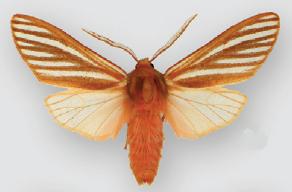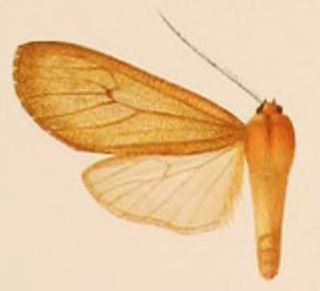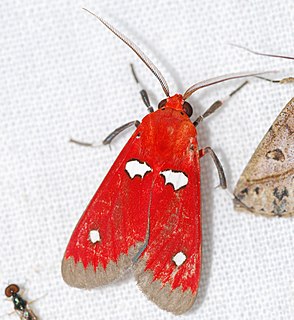
The Phaegopterina are a subtribe of tiger moths in the tribe Arctiini, which is part of the family Erebidae. The subtribe was described by William Forsell Kirby in 1892.

Amastus is a genus of moths in the family Erebidae. The genus was erected by Francis Walker in 1855.

Hyperthaema is a genus of moths in the family Erebidae. The genus was described by Schaus in 1901.

Pseudohemihyalea is a genus of moths in the family Erebidae described by Régo Barros in 1956. While the caterpillars of most species of Pseudohemihyalea feed on broad-leaved trees, the P. ambigua group has larvae that feed on conifers. Their forewing coloration has accordingly evolved to light-and-dark lengthwise striping, giving better camouflage among the slim needles of the host plants. In this, they seem to be convergent to certain geometer moths, such as Caripeta piniata or Sabulodes niveostriata.

Amastus rufocinnamomea is a moth of the family Erebidae first described by Walter Rothschild in 1909. It is found in Peru.
Amastus collaris is a moth of the family Erebidae. It was described by Gottlieb August Wilhelm Herrich-Schäffer in 1853. It is found in Venezuela, Peru, Colombia and Ecuador.
Amastus bicolor is a moth of the family Erebidae. It was described by Peter Maassen in 1890. It is found in Ecuador and Peru.
Amastus cellularis is a moth of the family Erebidae. It was described by Walter Rothschild in 1922. It is found in Peru.
Amastus mossi is a moth of the family Erebidae. It was described by Walter Rothschild in 1922. It is found in Peru and Ecuador.
Amastus walkeri is a moth of the family Erebidae. It was described by Walter Rothschild in 1922. It is found in Peru.
Hyperthaema cardinalis is a moth of the subfamily Arctiinae. It was described by Staudinger in 1875. It is found in Peru.
Hyperthaema caroei is a moth of the subfamily Arctiinae. It was described by Peter Jörgensen in 1935. It is found in Paraguay.

Hyperthaema hoffmannsi is a moth of the subfamily Arctiinae. It was described by Rothschild in 1909. It is found in Brazil and French Guiana.
Hyperthaema orbicularis is a moth of the subfamily Arctiinae. It was described by Peter Maassen in 1890. It is found in Colombia.

Hyperthaema pulchra is a moth of the subfamily Arctiinae. It was described by Rothschild in 1935. It is found in Colombia.
Hyperthaema punctata is a moth of the subfamily Arctiinae. It was described by Rothschild in 1935. It is found in Venezuela and French Guiana.
Hyperthaema ruberrima is a moth of the subfamily Arctiinae. It was described by William Schaus in 1905. It is found in French Guiana.

Hyperthaema sororita is a moth of the subfamily Arctiinae. It was described by Schaus in 1920. It is found in Guatemala.
Amastus modesta is a moth in the family Erebidae. It was described by Peter Maassen in 1890. It is found in Bolivia.





